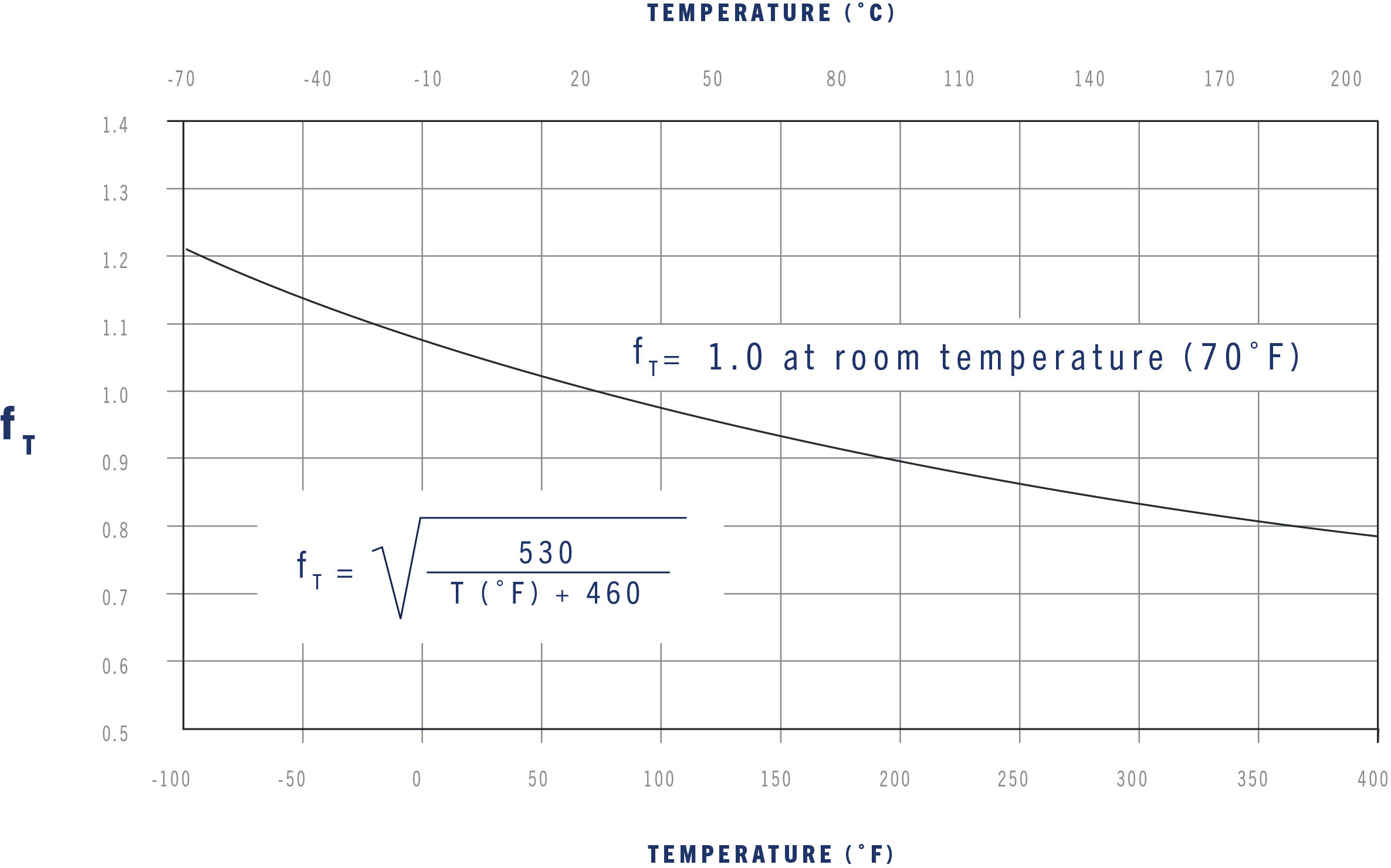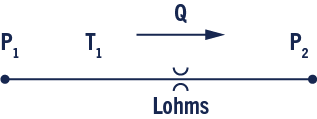The Lohm Laws extend the definition of Lohms for gas flow at any pressure and temperature, and with any gas. The formulas work well for all gases because they are corrected for the specific gas and for the flow conditions caused by the compressibility of gases due to pressure.
A 100 Lohm restriction will permit a flow of 250 standard liters per minute of nitrogen at a temperature of 59°F, and an upstream pressure of 90 psia discharging to the atmosphere.
The steps for using the gas Lohm rate formula are below. For more information about sonic and subsonic flow conditions, refer to Restrictions in Series or in Parallel.
i.e. P1/P2 ≥ 1.9
i.e. P1/P2 < 1.9
Where:
L = Lohm rate (Lohms)
K = Gas flow – Units Constant (see volumetric and gravimetric flow units in tables below)
fT = Temperature correction factor (see “Temperature Correction Factor fT” chart below)
P1 = Upstream absolute pressure
P2 = Downstream absolute pressure
Q = Gas flow rate
∆P = P1 – P2
Steps for using the gas Lohm Rate formula:

To eliminate the need to convert pressure and flow parameters into specific units such as psia and standard liters per minute, the tables below list the values of the units constant “K”, which is used in the gas flow Lohm formulas. Depending on your application, it may be more appropriate to use the volumetric or gravimetric flow units.
REFERENCE TABLE
| volumetric flow units | |||||||
|---|---|---|---|---|---|---|---|
| Abs. Pressure | psia | bar | kPa | mm Hg | |||
| Flow | SLPM | SCFM | in3/min | SLPM | SCFM | SLPM | ml/min |
| H2 | 1030 | 36.3 | 62700 | 14900 | 526 | 149 | 19900 |
| He | 771 | 27.2 | 47100 | 11200 | 395 | 112 | 14900 |
| Neon | 343 | 12.1 | 20900 | 4980 | 176 | 49.8 | 6640 |
| Nat. Gas | 319 | 11.3 | 19400 | 4620 | 163 | 46.2 | 6160 |
| N2 | 276 | 9.73 | 16800 | 4000 | 141 | 40.0 | 5330 |
| CO | 274 | 9.69 | 16700 | 2980 | 141 | 39.8 | 5300 |
| Air | 271 | 9.56 | 16500 | 3930 | 139 | 39.3 | 5230 |
| Ethane | 251 | 8.86 | 15300 | 3640 | 129 | 36.4 | 4850 |
| O2 | 257 | 9.08 | 15700 | 3730 | 132 | 37.3 | 4970 |
| Argon | 245 | 8.65 | 14900 | 3550 | 125 | 35.5 | 4730 |
| CO2 | 213 | 7.52 | 13000 | 3090 | 109 | 30.9 | 4110 |
| N2O | 214 | 7.56 | 13100 | 3100 | 110 | 31.0 | 4140 |
| SO2 | 176 | 6.21 | 10700 | 2550 | 90.1 | 25.5 | 3400 |
| Freon-12 | 123 | 4.34 | 7510 | 1780 | 63.0 | 17.8 | 2380 |
| Xe | 135 | 4.77 | 8253 | 1956 | 69.1 | 19.6 | 2605 |
REFERENCE TABLE
| Gravimetric Flow Units | |||||||
| Abs. Pressure | psia | bar | kPa | mm Hg | |||
| Flow | PPH | lbm/s | kg/min | PPH | kg/min | kg/min | gm/min |
| H2 | 11.6 | 0.00322 | 0.0876 | 168 | 1.27 | 0.0127 | 1.69 |
| He | 17.6 | 0.00479 | 0.131 | 250 | 1.89 | 0.0189 | 2.52 |
| Neon | 38.7 | 0.0108 | 0.293 | 561 | 4.25 | 0.0425 | 5.66 |
| Nat. Gas | 34.8 | 0.00966 | 0.263 | 505 | 3.82 | 0.0382 | 5.09 |
| N2 | 43.2 | 0.0120 | 0.326 | 626 | 4.73 | 0.0472 | 6.31 |
| CO | 43.0 | 0.0119 | 0.325 | 623 | 4.71 | 0.0471 | 6.28 |
| Air | 43.8 | 0.0122 | 0.331 | 636 | 4.81 | 0.0481 | 6.41 |
| Ethane | 42.2 | 0.0117 | 0.319 | 611 | 4.62 | 0.0462 | 6.16 |
| O2 | 46.0 | 0.0128 | 0.348 | 667 | 5.04 | 0.0504 | 6.72 |
| Argon | 54.6 | 0.0152 | 0.413 | 792 | 5.99 | 0.0599 | 7.99 |
| CO2 | 52.4 | 0.0145 | 0.396 | 759 | 5.74 | 0.0574 | 7.65 |
| N2O | 52.7 | 0.0146 | 0.398 | 764 | 5.77 | 0.0577 | 7.70 |
| SO2 | 62.0 | 0.0175 | 0.476 | 914 | 6.91 | 0.0691 | 9.21 |
| Freon-12 | 83.2 | 0.0231 | 0.629 | 1210 | 9.12 | 0.0912 | 12.2 |
| Xe | 97.6 | 0.0271 | 0.738 | 1415.6 | 10.7 | 0.1070 | 14.24 |
Gravimetric Example:
If a Lohm rate is being calculated for an Argon application using pounds per hour and bar as the flow and pressure units, the unit constant is 792.

EXAMPLE: What restriction will permit a flow of 1.00 SLPM of nitrogen at a temperature of 90°F with a supply pressure of 5 psig discharging to the atmosphere?
K = 276 (see table above)
T1 = 90°F, fT = 0.98 (see chart above)
P1 = 5.0 + 14.7 = 19.7 psia, P2 = 14.7 psia
P1/P2 = 19.7/14.7 = 1.34 (subsonic)
∆P = 5.0 psid
Q = 1.00 SLPM
Always verify flow calculations by experiment.
*There are many parameters to consider when determining V-Factor. Click here for more information.